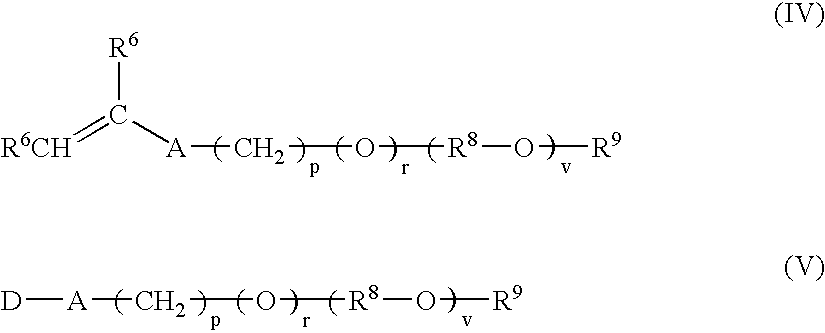Multi-purpose polymers, methods and compositions
- Summary
- Abstract
- Description
- Claims
- Application Information
AI Technical Summary
Benefits of technology
Problems solved by technology
Method used
Image
Examples
example 1
Polymers
[0195]The cationic acid-swellable associative polymer identified as Polymer A in Table 2 was prepared according to the general procedure described above, and as described in detail below.
[0196]A monomer emulsion was prepared by adding with mixing agitation about 56 parts by weight of ethyl acrylate, about 37 parts by weight of DMAEMA, about two parts by weight of HEMA, about three parts by weight of BEM25, about two parts by weight of R208 and about 0.15 parts by weight of TEGDMA into a reactor containing about 350 parts by weight of water containing about seven parts by weight C897 nonionic surfactant and about 0.3 parts by weight of sodium lauryl sulfate (30%) anionic surfactant. The resulting mixture was agitated (about 200 rpm) at a temperature in the range of about 30 to about 40° C. under a nitrogen atmosphere until an emulsion was obtained. A solution of about 0.15 parts by weight of sodium persulfate in about three parts by weight of water was then added to the monom...
example 2
Cationic Salt Compatibility
[0207]This example illustrates the compatibility of all of the cationic associative polymers of Example 1, except for Polymers H, X, and Y of Table 2, with cationic quaternary ammonium salt, cetyl trimethylammonium chloride (INCI name cetrimonium chloride, referred to herein for brevity as CTAC) based on Brookfield viscosity and turbidity (NTU). Aqueous compositions were prepared containing cationic associative polymer, as indicated below, at an active polymer weight concentration of about 2% and CTAC in amounts of about 0.5, 1 and 1.5 weight % (active weight basis). The viscosity and turbidity values, where determined, are shown in the following Tables 3, 3A, 3B and 3C.
[0208]
TABLE 3Polymer% CTACViscosityTurbidity2%0.511.5mPa · sNTUA25,000—AX26,500—AX16,750—AX10,2504B25,600—BX26,800—BX14,420—BX7,680—C16,700—CX27,150—CX15,650—CX8,100—D7,600—DX8,16020DX4,30010DX2,04010E16,580—EX16,46026EX9,28025EX4,29022F22,230—FX25,20014FX12,84012FX6,82012G15,500—GX17,250—G...
example 2a
[0214]This example illustrates the utility of the cationic associative polymers to provide substantively clear aqueous compositions of varying viscosity by appropriate selection of monomers and surfactants.
[0215]As shown in Table 3, Example 2, at a 2% active polymer weight in water, the cationic associative polymers, Polymers A-C, E-Q and S—W produced gels having a Brookfield viscosity in the range of about 12,100 mPa·s to about 31,350 mPa·s and Polymers D and R provided high Brookfield viscosities of about 7,600 mPa·s and 8,680 mPa·s, respectively.
[0216]At a 2% active polymer weight in water, Polymers H, X, and Y, shown in Table 2, Example 1, respectively, provided a high Brookfield viscosity of about 6,400 mPa·s, and gels of about 31,800 mPa·s, and 18,900 mPa·s.
[0217]Likewise, at a 2% active polymer weight in water, Polymers AA-AH, AJ-AN, and AP-AR, listed in Table 2A, Example 1, provided substantially clear gels having a Brookfield viscosity in the range of about 10,300 mPa·s to ...
PUM
| Property | Measurement | Unit |
|---|---|---|
| Percent by mass | aaaaa | aaaaa |
| Percent by mass | aaaaa | aaaaa |
| Percent by mass | aaaaa | aaaaa |
Abstract
Description
Claims
Application Information
 Login to View More
Login to View More - R&D
- Intellectual Property
- Life Sciences
- Materials
- Tech Scout
- Unparalleled Data Quality
- Higher Quality Content
- 60% Fewer Hallucinations
Browse by: Latest US Patents, China's latest patents, Technical Efficacy Thesaurus, Application Domain, Technology Topic, Popular Technical Reports.
© 2025 PatSnap. All rights reserved.Legal|Privacy policy|Modern Slavery Act Transparency Statement|Sitemap|About US| Contact US: help@patsnap.com



